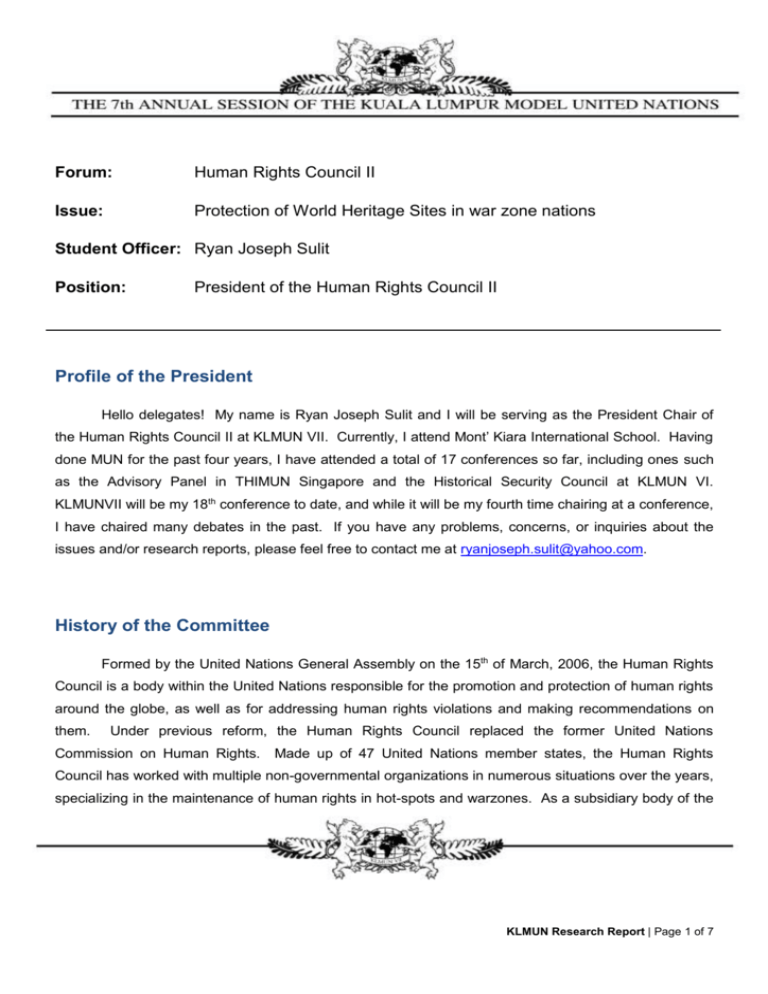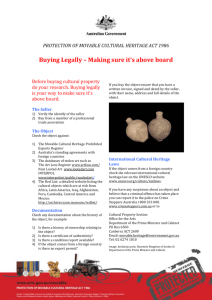Protection-of-World-Heritage-sites-in-war
advertisement

Forum: Human Rights Council II Issue: Protection of World Heritage Sites in war zone nations Student Officer: Ryan Joseph Sulit Position: President of the Human Rights Council II Profile of the President Hello delegates! My name is Ryan Joseph Sulit and I will be serving as the President Chair of the Human Rights Council II at KLMUN VII. Currently, I attend Mont’ Kiara International School. Having done MUN for the past four years, I have attended a total of 17 conferences so far, including ones such as the Advisory Panel in THIMUN Singapore and the Historical Security Council at KLMUN VI. KLMUNVII will be my 18th conference to date, and while it will be my fourth time chairing at a conference, I have chaired many debates in the past. If you have any problems, concerns, or inquiries about the issues and/or research reports, please feel free to contact me at ryanjoseph.sulit@yahoo.com. History of the Committee Formed by the United Nations General Assembly on the 15th of March, 2006, the Human Rights Council is a body within the United Nations responsible for the promotion and protection of human rights around the globe, as well as for addressing human rights violations and making recommendations on them. Under previous reform, the Human Rights Council replaced the former United Nations Commission on Human Rights. Made up of 47 United Nations member states, the Human Rights Council has worked with multiple non-governmental organizations in numerous situations over the years, specializing in the maintenance of human rights in hot-spots and warzones. As a subsidiary body of the KLMUN Research Report | Page 1 of 7 United Nations General Assembly, the Human Rights Council works with the Office of the High Commissioner of Human Rights and its non-governmental counterparts. Among its aims are for the promotion and protection of human rights, and an expectance of accountability from all member states of the United Nations to uphold the Universal Declaration of Human Rights and other relevant legal documents. Statement of the Problem Ever since the establishment of the United Nations Educational, Scientific and Cultural Organizations (UNESCO), the protection and maintenance of World Heritage Sites across the globe has been a prevalent issue on the United Nations Agenda. As a World Heritage Site, these special locations are granted special legal status as being considered under the protection of the Geneva Convention, specifically Article 53: “Protection of Cultural Objects and of Places of Worship.” Both under the Geneva Convention, UNESCO’s Convention Concerning the Protection of World Cultural and Natural Heritage, and other legal instruments, the protection of natural and cultural sites has been addressed in multiple forms. Unfortunately, World Heritage Sites in war-zone nations with undergoing conflicts are particularly vulnerable to destruction, pillaging, or other actions that results in unfortunate consequences. In areas where conflicting parties have chosen their battlegrounds on sacred places, places of cultural and natural importance have taken second seat to the alternate goals of said parties. As a result of the ignorance of proper guidelines and regulations concerning such locations, World Heritage Sites in conflict-ridden locations such as Syria and Palestine have deteriorated in an alarming rate. Often, rebel groups and movements choose various World Heritage sites as key base locations, and as such, these renowned places take enormous collateral damage in the midst of battle. Normal consequences and fines in the light of violations of Heritage Sites cannot be properly enforced due to the lack of law enforcement and chaos in these general regions. The proper identification of these violations themselves are out of the control of the relevant authorities, as such violations almost always go unrecorded and unobserved. KLMUN Research Report | Page 2 of 7 World Heritage Sites most vulnerable in these situations are locations currently being used by rebel groups or movements in member nations currently experienced civil conflicts. Militant groups utilize and exploit their knowledge of World Heritage Sites in order to gain an extra level of pseudo-protection from local government bodies. Local government bodies and authorities are then faced with a difficult decision: either allow the militant activities in these locations to go unfettered in order to uphold the UNESCO regulations, or uproot such militant bases at the collateral cost and possibility of damaging these Heritage Sites in the process. World Heritage Sites under military occupation has severely hindered all efforts in addressing the issue as a whole. With conflicts arising across the globe, the responsibility of improving the protection of World Heritage Sites in areas of conflict is increasing in difficulty. Local authorities and the World Heritage Committee itself has tried to curb the damages and effects of conflicts on said Heritage sites, but the danger present in such endeavors limit the actions that can be taken. In addition to the damaging of various Sites, looting and pillaging have caused precious artifacts to go missing from their respective locations, most notably those of cultural heritage. Definition of Key Terms World Heritage Committee Established by the United Nations Educational, Scientific, and Cultural Organization, the World Heritage Site Committee is responsible for choosing sites to be established as a UNESCO World Heritage Site. The committee primarily investigates locations around the world with significant cultural, or natural importance to the “common heritage of humanity.” With aid from advisory bodies such as the International Union for Conservation of Nature (IUCN), the International Council on Monuments and Sites (ICOMOS), and the International Centre for the Study of the Preservation and Restoration of Cultural Property (ICCROM), the World Heritage Committee determines and evaluates the statuses of all World Heritage Sites. KLMUN Research Report | Page 3 of 7 World Heritage Site Defined by the Oxford English Dictionary as a “natural or man-made site, area, or structure recognized as being of outstanding international importance and therefore as deserving special protection.” These Sites are to be designated and monitored by the World Heritage Committee. List of World Heritage In Danger Compiled by the UNESCO World Heritage Committee, the List of World Heritage in Danger was established under Article 11.4 of the World Heritage Convention for the purpose of documenting World Heritage Sites under conditions deemed to be “dangerous” or “of threat”; such dangers include deterioration of materials, and damaging of structures as a result of natural, geological, or human means. United Nations Educational, Scientific and Cultural Organization (UNESCO) Defined by the Oxford English Dictionary as “an agency of the United Nations set up in 1945 to promote the exchange of information, ideas, and culture.” Among its responsibilities are the maintenance of World Heritage Sites around the world through its subsidiary World Heritage Committee. World Heritage Convention Adopted in the aftermath of the Aswan Dam cultural preservation project, the World Heritage Convention is the legal instrument holding precedent over all current procedures and regulations concerning the designation, maintenance, and monitoring of World Heritage Sites. Currently, 191 member nations have signed on and ratified the World Heritage Convention. It is officially known as the Convention concerning the Protection of the World Cultural and Natural Heritage. KLMUN Research Report | Page 4 of 7 Timeline of Events Date Description of event May 14, 1954 The Hague Convention for the Protection of Cultural Property in the Event of Armed Conflict November 16, 1972 Adoption of the “World Heritage Convention” by the seventeenth session of the General Conference of UNESCO June 27 – July 1, 1977 First Session of the World Heritage Committee September 5 – 8, 1978 First List of World Heritage Sites released at the Second Session of the World Heritage Committee November, 1994 Global Strategy for a Representative, Balanced and Credible World Heritage Site Relevant International Actions/Past UN Efforts Under UNESCO, the Human Rights Council, and other relevant organizations, multiple conventions, treatises, and legal documents have been drafted all concerning the protection of World Heritage Sites and similar places. Conferences and resolutions also exist that aid in this issue. These include: The Hague Convention for the Protection of Cultural Property in the Event of Armed Conflict, 14 th of May, 1954 The Convention Concerning the Protection of the World Cultural and National Heritage Site, adopted by the General Conference of UNESCO on the 16th of November, 1972 Resolution Adopted by the 12th General Assembly of States Parties to the World Heritage Convention (on Global Strategy), WHC.03/14.GA/INF.8 KLMUN Research Report | Page 5 of 7 Expert Meeting on the “Global Strategy” and thematic studies for a representative World Heritage List, 18th Session of the World Heritage Committee, 12-17 November, 1994 Possible Solutions With normal procedure of the UNESCO World Heritage Committee unviable in these conflictsituations, one solution required is to create a legal framework that properly identifies and prosecutes individuals and/or parties responsible for the destruction or damaging of World Heritage Sites, whereby such legal actions will occur at a period of time to be decided by UNESCO and other relevant advisory bodies after the conflict has terminated. If individuals and/or parties who have made clear violations of the World Heritage Site guidelines are let go, then it sets a dangerous legal precedent whereby future individuals/parties will not hesitate to take a World Heritage Site as a result of a lack of enforcement. In addition to resolving the legal issues after conflicts, there exists the issue of the prevention of damage to World Heritage Sites currently in the middle of conflict. Sending United Nations personnel to deal with such situations is out of the question, and persuading local militia to add to their list of duties the protection of World Heritage Sites is also not likely. In truth, it would be up to the Human Rights Council, with its connection with the World Heritage Convention, to decide as to whether or not direct intervention in situations such as this would be the best option. Bibliography "Advisory Bodies - World Heritage Committee." UNESCO. United Nations, n.d. Web. 26 Dec. 2014. <http://whc.unesco.org/en/advisorybodies/>. "Definition: UNESCO." Oxford Dictionary. Oxford University Press, n.d. Web. 26 Dec. 2014. <http://www.oxforddictionaries.com/definition/english/UNESCO>. "Definition: World Heritage Site." Oxford Dictionary. Oxford University Press, n.d. Web. 26 Dec. 2014. <http://www.oxforddictionaries.com/us/definition/american_english/World-Heritage-Site>. Expert Meeting on the "Global Strategy" and Thematic Studies for a Representative World Heritage List. KLMUN Research Report | Page 6 of 7 Rep. Paris: n.p., 1994. UNESCO - World Heritage Committee. United Nations. Web. 26 Dec. 2014. <http://whc.unesco.org/archive/global94.htm>. "Heritage Sites Ravaged by Syria's War." Al Jazeera. Al Jazeera Media Network, 24 Dec. 2014. Web. 24 Dec. 2014. <http://www.aljazeera.com/news/middleeast/2014/12/syria-war-heritage-sites201412232326597765.html>. Hetter, Katia. "Peru Claims Greenpeace Damaged Ancient Nazca Lines." CNN. Cable News Network, 12 Dec. 2014. Web. 25 Dec. 2014. <http://edition.cnn.com/2014/12/12/travel/greenpeace-nazcalines-damage/>. "List of World Heritage in Danger." UNESCO World Heritage Centre. United Nations, n.d. Web. 26 Dec. 2014. <http://whc.unesco.org/en/danger/>. "World Heritage Centre - About." UNESCO. United Nations, n.d. Web. 26 Dec. 2014. <http%3A%2F%2Fwhc.unesco.org%2Fen%2Fabout%2F>. "World Heritage Centre - Sessions." UNESCO. United Nations, n.d. Web. 26 Dec. 2014. <http://whc.unesco.org/en/sessions/>. KLMUN Research Report | Page 7 of 7







